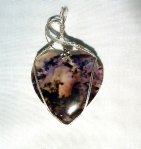- Tiffany-Stone-Opal pendant
This rock is composed of many different minerals,
which vary from sample to sample. It is found in nodules
and you have no idea what it is going to look like until you break them open.
It is found in the west desert of Utah,
near Spor Mountain, in a small area where they mine for beryllium.
It is very rare, both because it comes from such a small geographic area
and because much of it ends up in the ore crusher and gets destroyed. Now, due to National security reasons, rockhounds are no longer allowed to collect this material.
Some say the name tiffany stone came about because the
slab slices cut from the nodules reminded the miners of tiffany glass lamp shades.
Others say the name tiffany stone came about
because of a miner that used to pick up the nodules for his daughter Tiffany.
In either case, it is a name that people recognize in association with the nodules.
Tiffany Stone can be a soft to hard opalized stone that forms in very small to very large (100+ pound)
“mineralized nodules”, composed predominantly of opalized fluorite (blues, purples and whites),
often with many other minerals such as quartz, chalcedony, dolomite, rhodonite, manganese oxides (blacks),
bertrandite, beryl, solid white or translucent-yellowish opal, and other surprises included.
The best pieces for cabs are the opalized pieces, which cut well and take a beautiful polish.
Some other tidbits about tiffany stone –
~ Tiffany Stone formed from water circulating underground,
eventually penetrating nearby volcanic tuff layers
and precipitating out as fluorite-rich siliceous nodules.
The nodules consist mainly of quartz, chalcedony, agate and opal,
but the waters also contain numerous other elements
hat were picked-up as the water passed through other rock within the area.
Only 75% of the siliceous nodules contain fluorite,
and the nodules that do contain it vary considerably in total fluorite content.
The color of the fluorite varies from a light blue to a deep reddish-violet color to pink and red.
Slicing open the nodule often shows a wide variety of aesthetic and colorful patterns.
~ Mineralized nodules are locally abundant
in beryllium ore and represent altered clasts (fragments)
of carbonate rock. Other clasts, of quartzite, limestone, and volcanic rocks
, are little altered. Carbonate clasts show the alteration
sequence dolomite-calcite-chalcedonic quartz/opal-fluorite.
Some of the nodules have a very nice concentric structure,
with an interior of calcite, an intermediate shell of gray to black chalcedony,
and an outer, white to purplish layer of opalized fluorite.
~ Bertrandite is a colorless, white, yellow, or light pink mineral that contains beryllium
and is what the mine is seeking as a raw ore. The beryllium processed from the bertrnadite
is used in the production of missile nose cones (it does not heat up at high speeds)
and other high-tech metallurgical uses. Some say the beryllium is concentrated in the fluorite
(probably how the purple rock became known as bertrnadite),
as microscopic inclusions of the bertrandite crystals,
with generally not more than 1% bertrandite present.
Others say the bertrnadite is found in the soil and the nodules
are just dug up as the bertrandite is dug up. My guess is that both are true.
~ In either case, while mining for the bertrandite,
the tiffany stone nodules are dug up and end up in the overburden
(mining leftovers) and/or go through the ore crusher, to extract the
1% to 2% beryllium contained in the opal tuff.
The end result is that not only are Tiffany Stone nodules
rare because of their limited geographic location,
they are made even more rare (and consequently expensive)
because so few of them ever “escape”.
Please visit my web-store to view or purchase more examples of this marvelous stone :0) www.wrappedtogo.net


